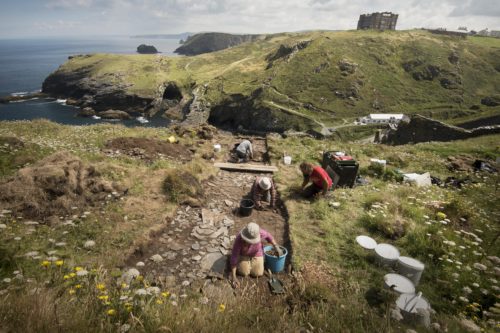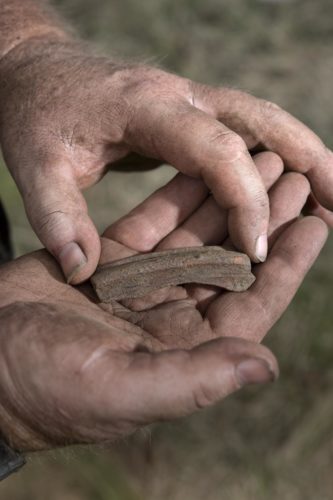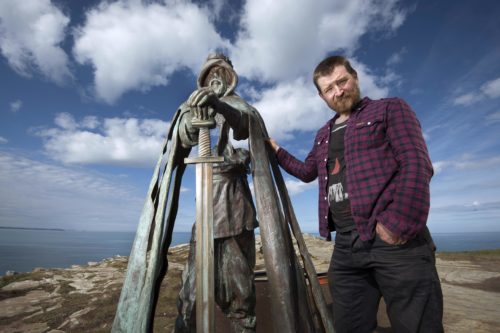An archaeological dig at the Tintagel heritage site in Cornwall, South West England, has uncovered a complex of well-constructed buildings dating to the 5th or 6th century that could have been a royal palace – fuelling age-old speculation that the area was the seat of King Arthur.

Tintagel Castle Archeology dig. [Photo Credit: Emily Whitfield-Wicks / Courtesy English Heritage]
Whoever lived there is thought to have been the ruler of the Dunmonnia tribe, which occupied the entire South West region of England at the time, including Cornwall. Each area had tribal Kings, and continued to do so until the 9th century when King Ecgbert of Wessex became the King of “All-England.”
It must to be remembered that, although the Anglo-Saxons had arrived in England by the 5th century, the Western half of England, including Cornwall, was still very much under the control of the ancient Britons.
Historically, Cornwall has always been an important strategic point, due to its geographical location and its natural resources – particularly tin. The region was famous for its tin mines, which made the region very useful to the Roman Empire. The trade made the area rich, even after the Romans lost their footing in Britain in 410 CE.

Ryan Smith (Trench Supervisor) holding a phocaean red slip water from Western Turkey [Photo Credit: Emily Whitfield-Wicks / Courtesy English Heritage
Win Scutt, English Heritage’s properties curator for the West of England, said, “The discovery of high-status buildings – potentially a royal palace complex – at Tintagel is transforming our understanding of the site. It is helping to reveal an intriguing picture of what life was like in a place of such importance in the historically little-known centuries following the collapse of Roman administration in Britain.”
This remains a landmark discovery regardless of any Arthurian connection. However, it has inevitably renewed debate on whether Tintagel was indeed the home of the legendary king, as told in the famous legend.
Many different regions lay claim to Arthur but most of those claims usually concern his final resting place. Glastonbury, in Somerset, has a historical claim in the grounds of its ruined Abbey, for example. A local legend at Alderley Edge in Cheshire, North-West England, claims that Arthur and the Knights of the Round Table are currently sleeping under the rocky outcrop that gives the region its name. This local legend continues that when England is in dire need, they will awaken to defend the land once more.
There is also a persuasive theory from alternative historians Alan Wilson and Baram Blackett that much of Arthur’s story took place in South Wales. They argue that the legends about him represent a conflation of two historical kings, both called Arthur, separated by several centuries.
It cannot be denied that the Arthur legend is still very popular in Britain – and he is being given his latest cinematic outing by director Guy Ritchie’s King Arthur: Legend of the Sword, which is due out next spring.
Most of conventional Arthurian legends come from Geoffrey of Monmouth’s Historia Regum Britanniae (History of the Kings of Britain). Geoffrey was a Welsh monk, although some think Breton, meaning from Brittany. This area in France was settled by a branch of Britons toward the end of the 4th century CE, who gave the region its name.
Incidentally, this is why Britain is referred to as Great Britain. It is not, as is commonly thought, a hangover from the days of Empire, but rather a way of distinguishing it from Brittany. Historically, Great Britain meant the larger mainland where Britons lived, and Brittany was known as Little Britain. This partly explains the confusion about Geoffrey of Monmouth, as interaction between the Britons of France – Bretons – and the ancient British would have been much more frequent than today.
Geoffrey was writing in the 12th century and claims to have translated a little-known Welsh book into English at the behest of his immediate superior Walter, the Archdeacon of Oxford.
![Tintagel Castle. Prince Dafydd's tale. [Photo Credit: Emily Whitfield-Wicks / Courtesy English Heritage]](https://wildhunt.org/wp-content/uploads/2016/08/Tthe-13th-century-ruins-at-Tintagel-credit-English-Heritage-500x333.jpg)
Tintagel Castle. Prince Dafydd’s tale. [Photo Credit: Emily Whitfield-Wicks / Courtesy English Heritage]
Geoffrey’s work has long been dismissed as mythical and fantastical, but his claims that Arthur was conceived and raised at Tintagel Castle (giving rise to the legend of Merlin disguising Uther Pendragon, Arthur’s father, as the Duke of Cornwall in order to sleep with Igrainne, Arthur’s mother), have been strengthened by the recent find at Tintagel.
The Dark Ages complex is not the only ancient ruin on the Tintagel headland. There are also the remains of a much later medieval structure from the 13th century, which belonged to Richard, Earl of Cornwall, who was the brother of Henry III.
The Kingdom of Cornwall has always been prized by British royalty, and Geoffrey notes that Brutus, the mythical Trojan founder of Britain, gave Corineus, his second in command, the region to preside over and settle. In more recent times, the position of Earl or Duke of Cornwall has been held by someone very close to the Monarch. At present Prince of Wales Charles, who will inherit the throne from his mother Elizabeth II, presides over the Duchy of Cornwall.
Like Arthurian lore, Tintagel offers layer upon layer of history and meaning, and is intricately woven into the fabric of the nation’s mythic life. The latest finds may be able to offer some more concrete pictures the Dark Ages. However, they may also offer a fresh chapter in King Arthur’s story.
* * *
Meanwhile, Tintagel has also been in the news this year due to regeneration plans by site manager English Heritage intended to raise visitor numbers.
A series of artworks exploring the myths and legends of the area have been commissioned and, to date, two are in place. A sculpture called Gallos, which is Cornish for “power,” was installed near the castle ruins on the headland in April. It’s creator, Rubin Eynon, says the piece is a warrior king who represents Tintagel’s royal past in general, but it is commonly referred to as Arthur.

Installation of King Arthur Sculpture by Rubin Eynon from South Wales. [Photo Credit: Emily Whitfield-Wicks / Courtesy English Heritage ]
But the works have proved divisive. Many visitors approve of them, but locals and supporters of the Tintagel heritage zone dismiss them as a cheapening or a desecration of the area or what has been referred to by some as “Disneyfication.”
The Merlin carving lost the end of its nose by May and, while English Heritage claimed it was due to storm damage, rumours abound of it being knocked off in protest.
![Merlin carving [Courtesy English Heritage]](https://wildhunt.org/wp-content/uploads/2016/08/Merlin-carving-credit-English-Heritage-500x352.jpg)
Merlin carving by Peter Graham [Photo Courtesy English Heritage]
The Wild Hunt is not responsible for links to external content.
To join a conversation on this post:
Visit our The Wild Hunt subreddit! Point your favorite browser to https://www.reddit.com/r/The_Wild_Hunt_News/, then click “JOIN”. Make sure to click the bell, too, to be notified of new articles posted to our subreddit.
Love the artwork, especially the “Merlin” carving. I’m sure that if these are not disturbed in about 10 years the locals will be exceptionally proud of them.
Well-written and fascinating.
Did you ever think that Arthur was a reference to acturus in the night sky, rather than an actual person.
How sad that she had to mention where Bretons are from.